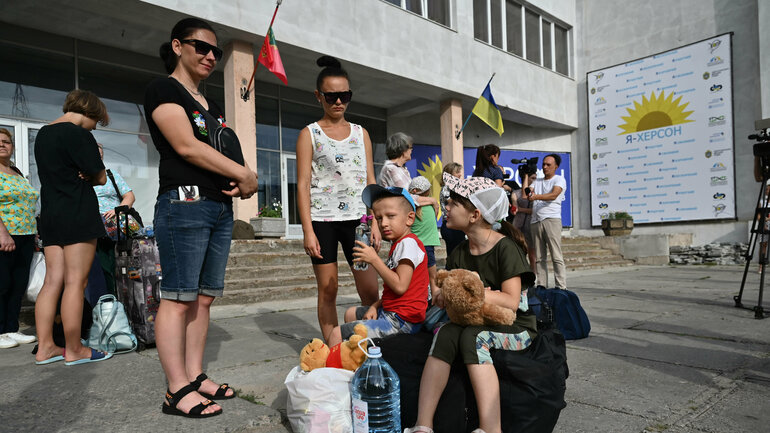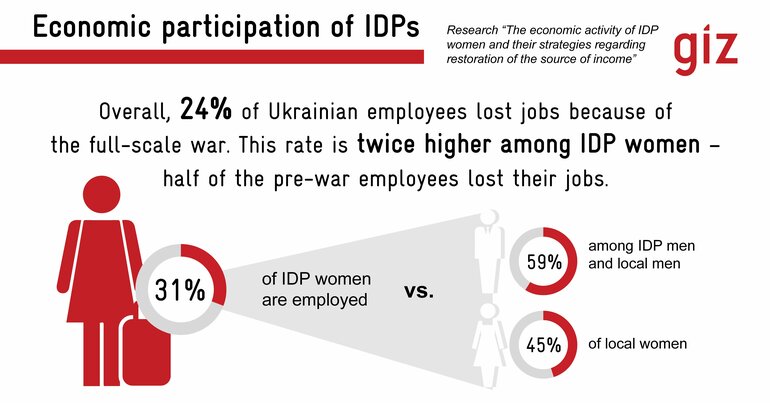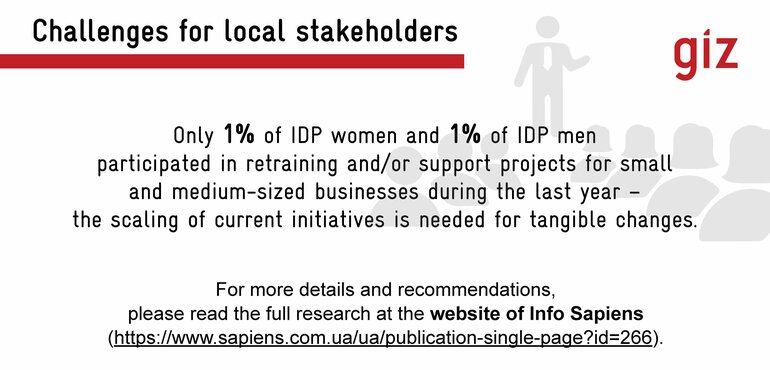The Economic Effects of Russia’s War on Ukraine’s Internally Displaced Women
As a result of the war, Ukraine is suffering from a severe economic crisis. In June 2023, a quarter of previously employed Ukrainians was still out of work, with women significantly more affected than men. A survey among internally displaced persons shows what makes their return to work difficult.

As a result of Russia’s aggression, Ukraine is suffering the greatest economic crisis of its post-independence history. According to the Ministry for the Reintegration of the Temporarily Occupied Territories of Ukraine, there were an estimated 7 million internally displaced persons (IDPs) in the country as of February 2023. The as yet unpublished Omnibus survey, conducted in March 2022 by the research agency Info Sapiens, revealed that one-third of all Ukrainians employed before the war, or 6.4 million employees, had lost their jobs since the start of the invasion. The situation started to improve in September 2022, but as of June 2023, 24 per cent of previously employed Ukrainians (4.8 million people) were still out of work because of the full-scale war.
Who has suffered the most and why?
According to another Info Sapiens survey, conducted in March 2023 for the German Agency for International Cooperation (GIZ), Ukraine’s internally displaced women have been more severely affected by unemployment than other groups. Fully half of internally displaced women who were employed before the war lost their jobs as a result of the Russian aggression (figure 1), compared with 28 per cent of internally displaced men and less than 20 per cent of the local population.
Figure 1

As a result of the massive job losses, Ukraine’s internally displaced women are the most financially vulnerable group: 59 per cent of them have to save up for basic needs, such as food and clothes, against 51 per cent of local women, 40 per cent of internally displaced men, and 35 per cent of local men (figure 2).
Figure 2

Some unemployed women are not looking for another job because of uncertainty about where they will be living: half of internally displaced women plan to change their place of residence in the next six to 12 months. Not all towns and cities have kindergartens, and schools often operate online, so mothers are unable to leave their children at home and go to work. Besides, one in five unemployed internally displaced women have difficulties in commuting, including, in some cases, a lack of transport. There is therefore high demand among jobseekers for remote work and flexible hours. At the same time, 5 per cent of unemployed internally displaced women complained in their survey responses about an absence of internet access.
Those looking for jobs face a lack of vacancies and labour market imbalances: highly skilled professionals cannot find jobs that correspond to their level of education and experience in their communities, and they are often unwilling to work in lower-level positions or undergo retraining. As for blue-collar workers, most have worked for a long time in specialised manufacturing and cannot find relevant employment in the same region. They need to retrain and learn a new profession but sometimes lack the motivation to do so.
One in ten unemployed women said they could not find a job because of poor mental health, including depression and apathy. Approximately the same share of women mentioned discrimination as a factor: employers are apparently afraid that women with children will often take sick leave and so prefer younger specialists.
The skills shortage that unemployed internally displaced women mentioned most often in the survey is insufficient knowledge of English or Ukrainian. The latter is especially important in Ukraine’s western and northern regions, where almost all of the population speaks Ukrainian, while in other regions, there are Russian-speaking minorities.
What can people do to recover their incomes?
Amid these challenges, Ukrainians have resorted to four main income recovery strategies:
- A change of profession: According to another unpublished Info Sapiens survey, conducted in June 2023 for the UN Population Fund (UNFPA), 17 per cent of the Ukrainian workforce changed profession after the full-scale Russian aggression, mostly to regain their incomes and take advantage of flexible working opportunities. Among those who changed jobs, 57 per cent had blue-collar professions before the invasion, compared with 63 per cent now – so the demand for these professions has increased as a result of the invasion. Among the new professions, the most prevalent are construction specialists and roles in the medical and trade sectors – professions that are in high demand for Ukraine’s postwar recovery.
- Part-time employment: According to the March 2023 survey, the share of part-time workers among employed women increased from 14 per cent to 26 per cent, while the share of full-time and self-employed workers decreased as a result of the war.
- Remote working: Thirty per cent of Ukraine’s internally displaced women work remotely, compared with 15 per cent of internally displaced men, 7 per cent of local women, and 5 per cent of local men.
- Social security and humanitarian assistance payments: Internally displaced women depend more than other groups on IDP payments and other social security and humanitarian handouts. On average, 59 per cent of an internally displaced woman’s household budget consists of social security and humanitarian assistance payments, compared with 42 per cent for internally displaced men, 44 per cent for local women, and 36 per cent for local men.
What can donors do to help?
To support Ukraine’s recovery, donors should focus more on job opportunities. First of all, donors should concentrate on supporting the employment of IDPs, specifically women, in particular in Ukraine’s southern and eastern regions. To this end, it is important to encourage cooperation between employment centres and NGOs that focus on IDPs and other vulnerable groups.
It is also important to support training programmes developed in cooperation with employers as well as internship programmes, local professional orientation projects, and courses in relevant subjects for professions that allow remote working and/or flexible hours. Entrepreneurship courses should also be a focus, as one in ten internally displaced women are interested in furthering their skills in this area. Initiatives should include mental health provision and childcare opportunities. Last but not least, it is essential to support anti-discrimination projects, specifically to combat ageism.
One possible format for support consists of microgrants for training, internet access, childcare services, and starting or developing a business. Yet, as of March 2023, only 1 per cent of internally displaced women and 1 per cent of internally displaced men had participated in retraining and/or support projects for small and medium-sized businesses during the last year (figure 3).
Figure 3

These statistics show that the scaling up of current initiatives is needed to ensure tangible changes for the benefit of Ukraine’s internally displaced population and the country’s long-term economic well-being.
Inna Volosevych is the deputy director of the Ukrainian research agency Info Sapiens and currently a fellow in the Ukraine Research Network@ZOiS.